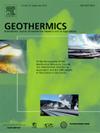西藏郭纳—桑日裂谷岩浆流体上涌的温泉异常硼同位素值及水化学特征
IF 3.5
2区 工程技术
Q3 ENERGY & FUELS
引用次数: 0
摘要
藏南地热系统蕴藏着大量的潜在能源和矿产资源。郭那桑日裂谷(CSR)的温泉;(中国)为Cl-Na型,微量元素(B、Li、Rb和Cs)浓度显著,δ11B值异常低。本研究旨在探讨库纳-桑日裂谷活跃带温泉化学同位素特征的来源、控制其化学同位素特征的理化过程。为了追索CSR泉水中水和溶质的来源,我们对泉水的主、次元素组成以及稳定同位素(δ2H-δ18O, δ11B)进行了表征。B、Li、Rb和Cs的异常丰度可能与岩浆流体输入有关,而不仅仅依赖于水岩相互作用。根据硼同位素,岩浆流体成分约占热水的1.74% ~ 8%。提出了一个概念模型来解释深断裂带控制的地热系统深部地下水循环的复杂模式。本文章由计算机程序翻译,如有差异,请以英文原文为准。
Unusual boron isotopic value and hydrochemical characteristics of thermal springs indicating magmatic fluids upwelling along Cuona-Sangri rift in the Tibet (China)
Geothermal systems located in southern Tibet exhibit a considerable amount of potential energy and mineral resources. Thermal springs from Cuona Sangri Rift (CSR; China) are Cl-Na type and exhibit notable concentrations of minor elements (B, Li, Rb, and Cs) and unusually low δ11B values. This study aims to explore the source(s), and physico-chemical processes controlling the chemical and isotopic features of the thermal springs in relation with the active Cuona-Sangri rift zone (CSR). In order to trace the origin of both water and solutes in the CSR springs, we characterized the major and minor element compositions, along with the stable isotope ratios (δ2H-δ18O, δ11B), of the spring water. The anomalous abundance of B, Li, Rb, and Cs is possibly related to magmatic fluid input rather than just dependent on water-rock interactions. According to boron isotopes, the magmatic fluid component accounts for approximately 1.74 % to 8 % of the thermal water. A conceptual model is proposed to elucidate the intricate patterns of geothermal system deep groundwater circulation controlled by the deep fault zone.
求助全文
通过发布文献求助,成功后即可免费获取论文全文。
去求助
来源期刊

Geothermics
工程技术-地球科学综合
CiteScore
7.70
自引率
15.40%
发文量
237
审稿时长
4.5 months
期刊介绍:
Geothermics is an international journal devoted to the research and development of geothermal energy. The International Board of Editors of Geothermics, which comprises specialists in the various aspects of geothermal resources, exploration and development, guarantees the balanced, comprehensive view of scientific and technological developments in this promising energy field.
It promulgates the state of the art and science of geothermal energy, its exploration and exploitation through a regular exchange of information from all parts of the world. The journal publishes articles dealing with the theory, exploration techniques and all aspects of the utilization of geothermal resources. Geothermics serves as the scientific house, or exchange medium, through which the growing community of geothermal specialists can provide and receive information.
 求助内容:
求助内容: 应助结果提醒方式:
应助结果提醒方式:


